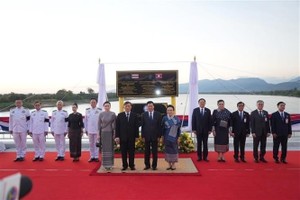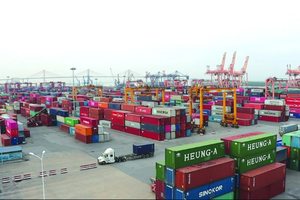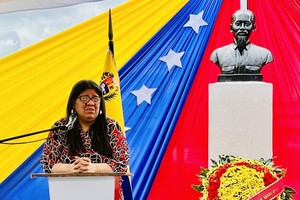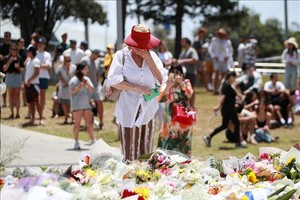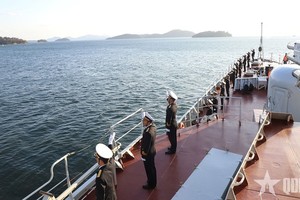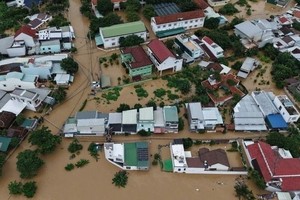NEW ORLEANS, Louisiana (AFP) – BP engineers wrestled a cap over a ruptured well gushing oil into the Gulf of Mexico, as a "furious" President Barack Obama prepared to head back to the stricken coast Friday.
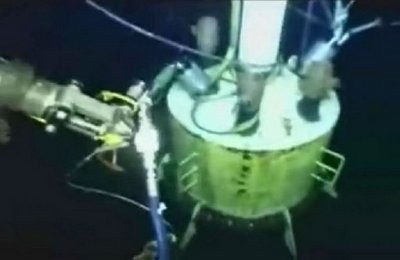
Remote-controlled submarines installed the cap over the spewing pipe nearly a mile (1,600 meters) below the surface late Thursday, but it remained unclear whether it was effectively containing the worst oil spill in US history.
With domestic anger mounting, Obama also postponed a trip to Australia and Indonesia set for later this month in a clear sign that the spill is now forcing changes in the president's crowded political agenda.
Admiral Thad Allen, the Coast Guard commandant and the official in charge of the government response to the disaster, called the cap effort "another positive development in BP's most recent attempt to contain the leak."
"However, it will be some time before we can confirm that this method will work and to what extent it will mitigate the release of oil into the environment," he said.
"Even if successful, this is only a temporary and partial fix and we must continue our aggressive response operations at the source, on the surface and along the Gulf's precious coastline," he said.
A live video feed showed oil gushing from the inverted, funnel-like cap long after it had been placed over a sawed-off riser pipe in near-freezing waters. BP intends to siphon the oil to a ship on the surface.
Shocking images of pelicans and seabirds writhing in oil along the Louisiana coast were carried on US television networks, graphically underscoring the disaster's rising costs.
Making his third visit to Louisiana since BP's Deepwater Horizon rig exploded April 20, killing 11 workers, Obama planned to meet with Allen as well as state and local elected officials.
The president has come under growing criticism for seeming disengaged from the growing public outrage over the disaster and BP's failure to stem the leak.
"I would love to just spend a lot of my time venting and yelling at people, but that is not what I was hired to do -- my job is to solve this problem," Obama told CNN Thursday, adding he was "furious at this entire situation."
He also disputed claims that political trauma over America's worst environmental catastrophe would crimp his broader political agenda.
Early Friday, however, White House spokesman Robert Gibbs announced that Obama had called the leaders of Australia and Indonesia to tell them he had decided to postpone a trip later this month.
It was the second time this year he had put off the trip to Indonesia, a southeast Asian heavyweight where Obama spent four years as a youth.
In Canberra, a spokesman for Prime Minister Kevin Rudd said Obama "explained the challenge represented by the BP Deepwater Horizon oil spill, and the continuing strong efforts of the administration to respond to that."
More than six weeks into the disaster, the federal government sent BP a 69-million-dollar bill to reimburse American taxpayers for the government's costs so far in battling the worst oil spill in US history.
Spreading in oily ribbons, the slick is now threatening Alabama, Mississippi and Florida after contaminating more than 125 miles (200 kilometers) of Louisiana coastline.
Scientists also warned the impact of "invisible" undersea oil may be felt for years.
"The public is seeing just a small fraction of what is taking place out there. Most of the oil is under the surface," Larry Schweiger, president and chief executive officer of the National Wildlife Federation, told AFP.
BP earlier managed to slice off the fractured well pipe with a pair of giant shears, but the cut was jagged and officials had to resort to a looser-fitting cap.
In the meantime, with the broken pipe cut off, oil was expected to flow from the well at rate up to 20 percent greater.
The US government has estimated the flow of oil before the riser was cut away at 12,000 to 19,000 barrels a day -- meaning between 22 million and some 36 million gallons have already poured into the Gulf.
By comparison, Alaska's 1989 Exxon Valdez disaster -- the worst US oil spill before the Deepwater Horizon blast -- resulted in an 11-million-gallon spill.
After the cap, the next chance to halt the flow of oil would not come until mid-August, when two relief wells are due to be completed.


